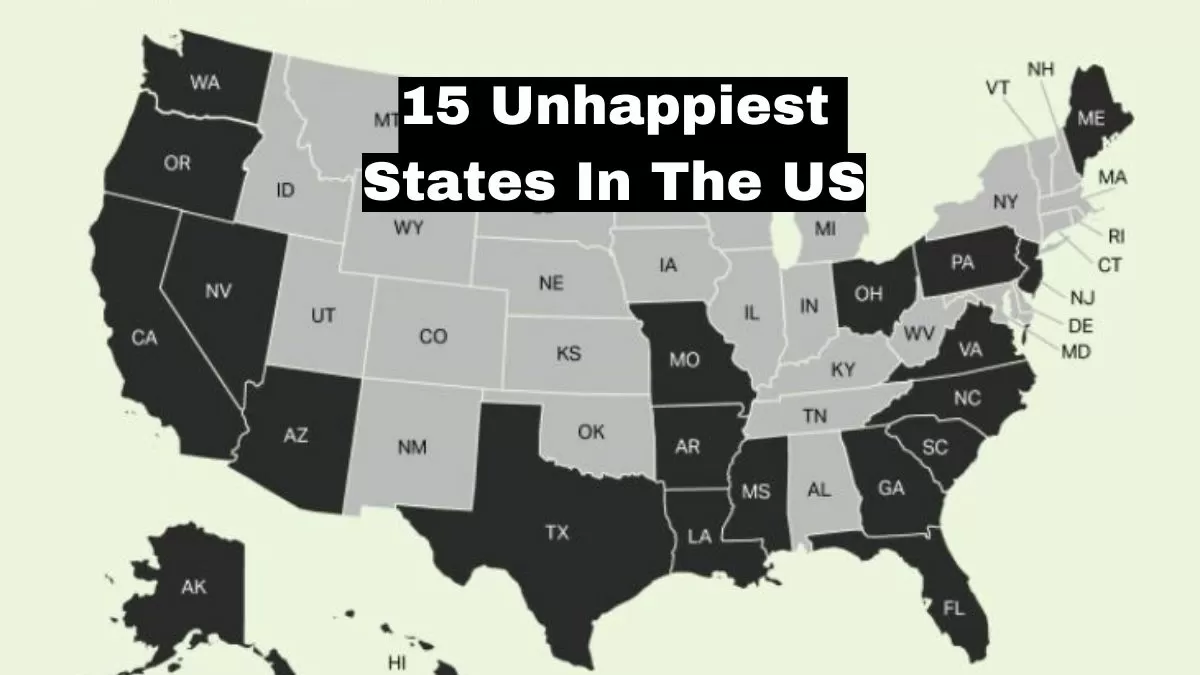In the vast tapestry of the United States, there’s a mosaic of emotions that color the experiences of its inhabitants.
From the vibrant bustle of city life to the serene quietude of rural landscapes, happiness is a subjective lens through which we view our surroundings.
However, recent studies have attempted to quantify this elusive concept, shedding light on the “unhappiest” states in the US.
But what exactly makes these states rank lower on the happiness scale? Let’s delve into the factors that contribute to this perception and uncover the stories behind the statistics.

Understanding the Metrics: What Defines Happiness?
Before diving into the rankings, it’s crucial to grasp the metrics used to measure happiness.
While subjective well-being surveys and objective indicators such as economic prosperity play a role, other factors like social support, freedom to make life choices, and perceptions of corruption also influence overall happiness.
These multifaceted aspects paint a nuanced picture of a state’s collective well-being.
Breaking Down the Rankings
-
Economic Struggles and Unemployment Rates
Economic stability often correlates with happiness, and states grappling with high unemployment rates and economic disparity tend to fare poorly in happiness rankings.
States like West Virginia and Mississippi consistently feature at the bottom due to economic challenges that impact residents’ quality of life.
-
Healthcare Accessibility and Quality
Access to affordable healthcare is a fundamental component of well-being. States with limited healthcare infrastructure or high uninsured rates, such as Louisiana and Arkansas, face challenges in providing adequate medical services to their residents, impacting overall happiness levels.
-
Educational Opportunities
Education serves as a pathway to prosperity and fulfillment. States with lower educational attainment levels often struggle to provide opportunities for personal and professional growth, contributing to feelings of dissatisfaction among residents.
States like Alabama and Oklahoma grapple with educational disparities that affect happiness metrics.
-
Social Support Networks
Human connection is a cornerstone of happiness, and states fostering strong social support networks tend to rank higher in happiness indices.
Conversely, states with higher rates of social isolation or limited community cohesion, such as Kentucky and Tennessee, may experience lower happiness levels among residents.

The Role of Environment and Culture
Beyond quantifiable metrics, environmental factors and cultural nuances also shape perceptions of happiness.
States with breathtaking natural landscapes or vibrant cultural scenes may offset socioeconomic challenges with a sense of belonging and identity.
Conversely, states grappling with environmental degradation or cultural tensions may experience a decline in overall happiness.
Conclusion
The quest to uncover the “unhappiest” states in the US is a complex endeavor that transcends statistical analysis.
While economic indicators and social factors provide valuable insights, true happiness is a deeply personal journey influenced by a myriad of factors.
By understanding the challenges faced by states at the bottom of happiness rankings, we can work towards fostering environments that prioritize well-being and cultivate a happier society.

FAQs (Frequently Asked Questions)
- How are happiness rankings determined?
Happiness rankings are typically determined through a combination of subjective well-being surveys, objective indicators such as economic prosperity and healthcare accessibility, and qualitative assessments of social factors.
- Do weather and climate play a role in happiness rankings?
Weather and climate can influence happiness to some extent, with states experiencing milder climates often ranking higher. However, the impact of weather on happiness is subjective and varies among individuals.
- Are there initiatives to improve happiness levels in the “unhappiest” states?
Yes, various initiatives focus on addressing underlying issues such as economic disparity, healthcare accessibility, and community development to improve happiness levels in states facing challenges.
- What can individuals do to improve their happiness in these states?
Individuals can focus on building strong social connections, pursuing personal growth opportunities, and engaging in activities that bring joy and fulfillment, regardless of their geographical location.
- How can policymakers contribute to increasing happiness levels in their states?
Policymakers can prioritize policies that promote economic prosperity, invest in healthcare infrastructure and education, and foster community engagement to create environments conducive to happiness and well-being.
